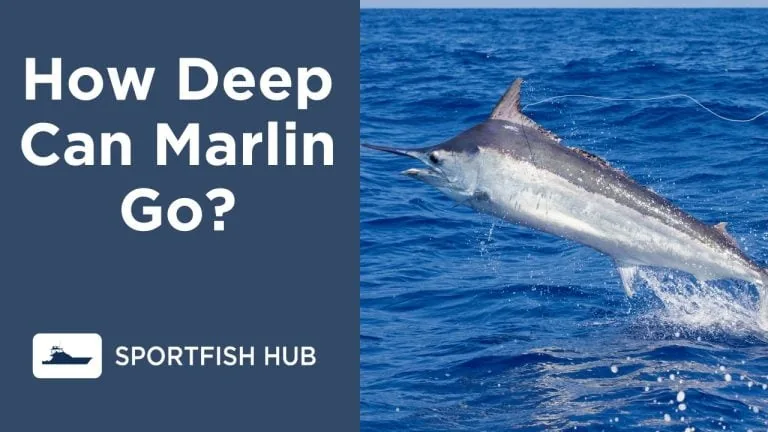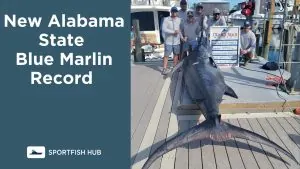Understanding marlin habitat, biology, and behavior is key to improving your ability to catch, release, and help preserve the species.
This blog post explores how deep various marlin species, such as the Pacific Blue Marlin and Atlantic Blue Marlin, can go while examining the unique adaptations that allow them to thrive in extreme oceanic conditions.
Key Takeaways
- Marlin species like the Pacific Blue Marlin and Atlantic Blue Marlin can dive to depths of over 1000 meters, with some reaching over 800 meters in temperatures as low as 17°C.
- Marlin’s physical adaptations, such as their specialized circulatory system, large eyes optimized for underwater visibility, concentrated muscle towards the center of their body, bill or upper jaw, serve as hunting equipment, help them survive in harsh dhow deep-sea environments.
- The deep diving capabilities of marlin have significant implications for conservation efforts and scientific research aimed at understanding marine biodiversity. Continued monitoring and studying of blue marlin will lead to better management strategies that safeguard this endangered species’ survival and ecological importance.
The Depths Marlin Can Reach
Marlin are known to dive to impressive depths, with some species capable of reaching 1,000 feet or more below the surface.
Research Findings
Recent research on marlin diving depths has shed light on the incredible capabilities of this species.
One notable study utilized electronic tags placed on blue marlin in the Atlantic Ocean to track their movements and gather data, with some fascinating results:
The deepest recorded descent for a blue marlin reached an astounding depth of 2,735 feet (835 meters), where they encountered temperatures as low as 17°C (63°F).
Additionally, billfish vision is optimized for underwater visibility at depths ranging from approximately 150 meters to 250 meters (490 feet -820 feet) in clear water conditions.
Blue marlin use this keen eyesight advantage when hunting prey like tuna or dolphin fish at different oceanic depths while navigating various light conditions.
While there is still much we don’t know about how deep marlin can go, ongoing marine research efforts continue uncovering invaluable insights into their behavior, biology, and habitat preferences – all essential information not only for anglers but also for those dedicated to protecting and preserving the Marlin Species.
Physical Adaptations For Deep Diving
Marlins are known for their deep-diving capabilities, and one of the reasons they can go so deep is because of their physical adaptations.
For instance, marlin have a specialized circulatory system that allows them to retain heat better than most other fish.
This feature helps them tolerate colder temperatures at deeper depths.
Furthermore, marlin bodies are built with muscles concentrated towards the center of their body which allows them to generate more power when swimming against strong currents or during rapid ascents from great depths.
Another physical adaptation worth mentioning is their bill or upper jaw – this doubles up as hunting equipment that helps stun and slash prey with lightning-fast movements – particularly useful when capturing fast-moving creatures such as tuna and swordfish.
Overall, these adaptions make Marlin ideal hunters perfectly adapted for surviving in some of the harshest places on earth.
Challenges And Risks Of Deep Diving For Marlin
Despite their physical adaptations for deep diving, blue marlin face significant challenges and risks in the depths of the ocean, including pressure and temperature changes as well as difficulties hunting and feeding.
Pressure And Temperature Changes
As marlin dive deeper into the ocean, they encounter significant pressure and temperature changes. This can be challenging for these large predatory fish, as their bodies are not designed to withstand such extreme conditions.
The decrease in temperature at deeper depths can slow down digestion and metabolism, making it difficult for marlin to hunt and feed efficiently.
Additionally, the increased pressure can lead to decompression sickness or “the bends” if they ascend too quickly.
Hunting And Feeding Difficulties
Marlin are apex predators, and their hunting style requires them to cover a significant distance in pursuit of prey.
Their primary diet consists of squid, tuna, and other smaller fish species.
However, hunting for food can be exceptionally challenging in the deep sea environment due to the potential scarcity of regular Marlin bait at extreme depths.
The pressure changes at these depths can also make it harder for the marlin’s eyesight to function optimally, as they tend to rely on visual cues when hunting their prey.
To combat this limitation, they use lateral line sensors to detect movement through water vibrations created by swimming prey.
Implications Of Marlin’s Depth Capabilities
Marlin’s depth capabilities have significant implications for conservation efforts and scientific research, as they provide valuable insight into the functioning of deep-sea ecosystems and the impact of human activities on marine biodiversity.
Impact On Conservation Efforts
The deep diving capabilities of marlin have significant implications for their conservation. As these large predatory fish venture into the ocean’s depths, they encounter unique challenges and risks that could impact their survival.
By understanding the depths at which marlins can go, scientists can better develop fishing regulations and conservation efforts to protect these endangered species. Additionally, studying marlin’s physical adaptations for deep diving can provide valuable insights into how marine biodiversity adapts to life in extreme environments.
Conclusion
In conclusion, while there is no specific information on exactly how deep marlins can go, research shows that they are capable of diving to depths beyond 1000 meters.
Marlin possesses unique physical adaptations that enable them to survive in the deep sea environment where pressure and temperature changes pose serious challenges.
However, the dangers associated with deep diving for marlin also include hunting and feeding difficulties. These majestic creatures play a vital role in marine biodiversity, making their conservation efforts crucial for maintaining healthy ocean ecosystems.












